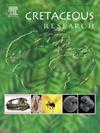The last non-avian theropods of Europe: Palaeoecology and biogeography inferred from dental records from the uppermost Maastrichtian of Catalonia, Spain
IF 1.7
3区 地球科学
Q1 GEOLOGY
引用次数: 0
Abstract
Non-avian theropods were essential components of terrestrial ecosystems during the Mesozoic, were highly diverse in size and lifestyles across different regions of the planet. Here we assess the composition and diversity of the theropod fauna of the Ibero-Armorican island (the ancient region that encompassed present-day areas of Spain, Portugal, and France) during the final few hundred thousand years of the Cretaceous, by reviewing the theropod teeth assemblage from the locality of Molí del Baró-1 (upper Maastrichtian, C29r, Catalonia, Spain). Our study indicates a diverse fauna of small non-avian theropods with different feeding strategies and ecological niches. The tooth assemblage is significantly more diverse than previously thought and includes dental elements referred to dromaeosaurines, velociraptorines, troodontids, and an undetermined Dromaeosauridae tooth with similarities to microraptorines, as well as previously-referred teeth of cf. ?Richardoestesia and aff. Paronychodon. Microwear analysis reveals diverse feeding styles among these theropods, and particularly indicates that the troodontid had an omnivorous diet heavy in plant consumption. The assemblage of small-sized non-avian theropods and medium-to large-sized abelisaurids from the uppermost Maastrichtian of Ibero-Armorica differs from others from the European archipelago and worldwide, illustrating the high regional variability of theropod faunas around the time the asteroid impact ended the Cretaceous.
欧洲最后的非鸟类兽脚亚目动物:从西班牙加泰罗尼亚马斯特里赫特人的牙齿记录推断的古生态学和生物地理学
非鸟类兽脚亚目是中生代陆地生态系统的重要组成部分,在地球不同地区的大小和生活方式高度多样化。在这里,我们通过回顾Molí del Baró-1(上马斯特里赫特,C29r,西班牙加泰罗尼亚)地区的兽脚亚目动物牙齿组合,评估了白垩纪最后几十万年伊比利亚-阿莫里亚岛(古代地区包括今天的西班牙、葡萄牙和法国地区)兽脚亚目动物群的组成和多样性。我们的研究表明,小型非鸟类兽脚亚目动物群具有不同的摄食策略和生态位。该牙齿组合比之前认为的要多样化得多,包括被称为驰龙类、迅猛龙类、齿状突类的牙齿元素,以及一种与小盗龙相似的未确定的驰龙科牙齿,以及之前被称为cf. richard estesia和aff. Paronychodon的牙齿。微磨损分析揭示了这些兽脚亚目动物不同的摄食方式,特别表明齿形兽以植物为主的杂食性饮食。来自伊比利亚-阿莫里卡岛最上层马斯特里赫特岛的小型非鸟类兽脚亚目和中型至大型阿贝利龙的组合不同于欧洲群岛和世界范围内的其他恐龙,说明了在小行星撞击结束白垩纪前后兽脚亚目动物群的高度区域变异性。
本文章由计算机程序翻译,如有差异,请以英文原文为准。
求助全文
约1分钟内获得全文
求助全文
来源期刊

Cretaceous Research
地学-地质学
CiteScore
4.10
自引率
19.00%
发文量
235
审稿时长
12 weeks
期刊介绍:
Cretaceous Research provides a forum for the rapid publication of research on all aspects of the Cretaceous Period, including its boundaries with the Jurassic and Palaeogene. Authoritative papers reporting detailed investigations of Cretaceous stratigraphy and palaeontology, studies of regional geology, and reviews of recently published books are complemented by short communications of significant new findings.
Papers submitted to Cretaceous Research should place the research in a broad context, with emphasis placed towards our better understanding of the Cretaceous, that are therefore of interest to the diverse, international readership of the journal. Full length papers that focus solely on a local theme or area will not be accepted for publication; authors of short communications are encouraged to discuss how their findings are of relevance to the Cretaceous on a broad scale.
Research Areas include:
• Regional geology
• Stratigraphy and palaeontology
• Palaeobiology
• Palaeobiogeography
• Palaeoceanography
• Palaeoclimatology
• Evolutionary Palaeoecology
• Geochronology
• Global events.
 求助内容:
求助内容: 应助结果提醒方式:
应助结果提醒方式:


